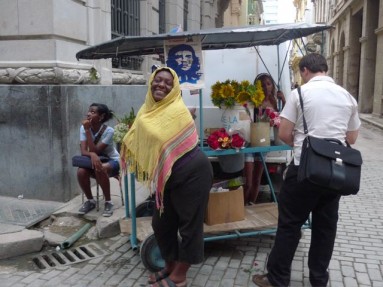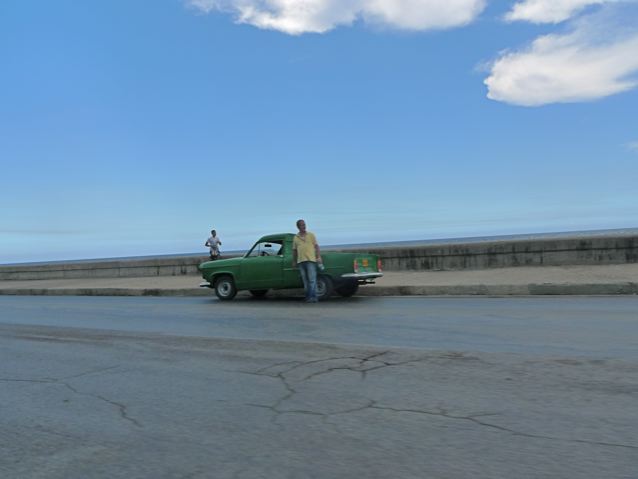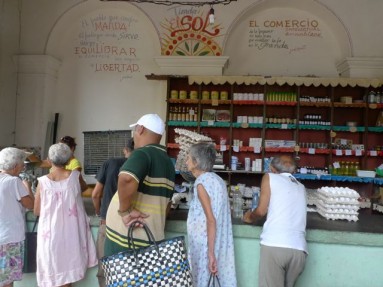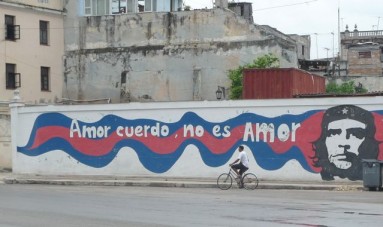Cuba is the One — Let Yourself Go!
Cuba is not just another Caribbean island … Cuba is the island.
— Cubana Air advertisement
In Havana, there are no billboards hawking Coca-Cola, home mortgages, or vacation getaways. But there are plenty of signs, many hand-painted, touting the Revolution (“With our ideas, we make the future”) or reminding Cubanos to use condoms. Che Guevara’s huge visage offers a stark choice: Socialismo o Muerte—socialism or death. Passing motorists are implored to build an egalitarian society where poverty is rooted out and the rich would not ransack the rest.
For the past fifty years, many of those who visited Cuba were drawn by the chance to witness a society that embodied a future-oriented egalitarianism. Che Guevara and other leaders of the Revolution saw capitalism as a "contest among wolves" where "one can only win at the cost of others," and they envisioned the nation as the crucible of a "new man and woman."
Today, in an era when Cuba is increasingly isolated, such dreams are overshadowed by the daily struggle for survival. The economic crisis has taken the sheen off the Cuban experiment, and fewer travelers come to take in the nation’s revolutionary innovations. It’s difficult when no hay –“we don't have”—is the refrain one hears on the street. No hay milk. No hay salt. No hay meat.
The shortages vary from week to week and from day to day, but the sense of deprivation is widespread and palpable. In the Vedado neighborhood of Havana, which with its lively mix of fading art deco hotels and residential buildings looks like a shabbier Miami Beach, people line up in front of a store because there is soap for sale. There is no milk, however. A few days later, there is milk, but little else, and still lines form around the block. Laura, a 60-year-old who runs a casa particular, renting out her two extra rooms to tourists, laments, “No hay nada”—we have nothing.
Hulking 1950s American automobiles roam the streets of Havana, held together with parts lovingly fabricated by local mechanics, alongside tiny 40-year old Soviet-made Ladas that resemble Fiats. In the face of acute shortages of just about everything, little is thrown away. If someone can’t use something – an old lamp, a battered bed frame—they repair it, give it to a neighbor, or repurpose it.
The value placed on durability, while borne of necessity, extends to relationships too. Sylvia, a retired architect and Gloria, a doctor, a couple who live in the city, are among the lucky few with access to email. One has an uncle who is a high-ranking member of the government, so they are allotted 80 minutes of dial-up access a month that they share with six other relatives. They also share their monthly food allotment: fish, eggs, bread. Sylvia and Gloria provide the ingredients, and in exchange, their relatives, who have less money, do the cooking. Slow food, indeed.
To a privileged tourist from the north, Cuba’s reciprocity, simplicity, and warmth seem like enviable qualities that are missing from our own lives. Visitors often describe it as a place that is “stuck in time.” But one person’s authenticity is another’s deprivation. While American visitors of a certain ilk luxuriate in a “realness” made possible by Cuba’s remove from global capitalism, the state is busily beefing up a tourist industry that calls it all into question.
***

Cuba suffered mightily after the collapse of the Soviet Union in 1989. Hoping to stave off economic ruin, the government began to encourage limited forms of entrepreneurial activity and grudgingly opened the country up to the global market. During the 1990s, the “Special Period in a Time of Crisis” in official parlance, dollars became king: Remittances from family members in the United States infused cash into an economy that was effectively isolated from the rest of the world. The state redoubled its efforts to attract tourists, aided in part by the “discovery” of Cuban music by the West, thanks to the wildly successful Buena Vista Social Club, whose 1997 album sold eight million copies worldwide. During the past few years, Raúl Castro slashed public payrolls and bolstered private enterprise, especially in businesses that cater to tourists.
Now, every year 2 million holidaymakers, mainly from Europe, Canada, and Latin America, flock to the island’s beach resorts or to the capital’s beautiful, crumbling colonial neighborhoods. Recently, I was among them. In search of sundrenched socialism, I booked a 10-day trip to Cuba that included a week in Havana and a few days in the interior. This required a minor act of subterfuge. It’s legal for Americans travel with organized “people to people” delegations, package tours with an educational bent, or to visit relatives. But I decided to strike out on my own with a Canadian-issued visa.
When I first announced I was planning to visit the island, I was surprised to learn how many friends of mine had already been there, accompanying delegations of journalists, artists, Quakers, lawyers, musicians, and progressives of different hues. Most of these visitors remain passionate about the country, marvel at its high rates of literacy, its universal and generally high-quality health care and its creole stew of a culture that’s seemingly devoid of familiar forms of racism.
While many of Cuba’s visitors have access to consumer choices and personal freedoms our grandparents would never have dreamed of, our cities, our communities, and even our relationships often seem transient, privatized, unmoored. When things and information circulate at a breakneck pace, our lives are in perpetual motion. In Cuba, life moves along slowly. When he learned I was from the United States, a waiter at the Havana Libre Hotel—a Hilton before the Revolution—proudly told me that he’s a fan of the Doobie Brothers. If “I point my radio right,” he said, “I get American music.”
From Havana I traveled to the three-star Brisas Trinidad del Mar, an all-inclusive resort on the Playa Ancon, near Trinidad. There I found three restaurants, two bars, a 24-hour snack bar, and an exuberant young woman who organized bingo games, Afro-Cuban dance lessons, folk-music performances, breakdance exhibitions. The place was filled with European and Latin American tourists in search of a cheaper alternative to Cancún. The food in the dining room, which accommodated several hundred visitors, while plentiful, did not change much over the course of the two days I was there, but the lackluster offerings were more than made up for by the enthusiastic attention of the staff.
Though the resort was less than half full, the cavernous dining room buzzed with smiling employees whose main job, it seemed, was to keep busy. The food was arranged buffet style, with each table assigned a waiter who was charged with the task of bringing drinks and dessert utensils to guests upon their request. “Madame, it’s so nice to see you today,” said one waiter, who politely caressed my hand and offered me a spoon. One night, he presented me with a gift of a postcard and handmade beaded bracelets. “Would you like a special meal?” he inquired, promising to arrange a special shrimp dinner the next day. “Only for you,” he said.
The next morning, as I was about to check out, the love bombs continued. A handwritten note delicately cut in the shape of a flower was placed on the bed, next to a swan and teddy bear elaborately sculpted out of towels. “Good morning,” the note read. “I’d like to say goodbye. I wish you have a happy flight and successful in your personal, in your professional life. Come back soon. Signed, Your maids.”
In a country where the per capita income is less than $10,000, it makes perfect sense that when Cubans see tourists, they see dollar — and euro — signs. And it’s no surprise why many of the best and brightest in this highly educated nation seek employment in tourism, one of the economy’s few growing sectors: taxi drivers are among the highest paid workers, and tour guides shuttling visitors around Havana or on excursions to the colonial town of Trinidad or Veradero, a beach resort, earn a lot more than college professors.
In the “legitimate” tourist economy, workers’ engage in herculean efforts to wrest tips. In the informal and often illegal economy on its edges, hustlers, jineteros, procurers, or middlemen, reel customers in, selling counterfeit or stolen cigars, or suggesting restaurants and accommodations—to which they often accompany them. In the bus station of Cienfuegos, a sad-faced man offered me a ride back to the capital, promising to undercut the fare on government-run buses by at least 5 CUCs — convertible pesos worth about 20 times the regular Cuban peso and spendable at better-stocked stores. I said I was not interested, but he continued to pursue me into the bus station undaunted. “Ride with me,” he said, “in my nice air-conditioned car.” It was “official taxi,” and it would be safer and cheaper than the bus, he promised. To prove it, he took out is wallet and showed me a picture of an angelic two-year-old boy — his son.
Beaten down by his pleas, I was led out of the station and introduced to a different man, who walked me over to yet another man who really did have a car — with a cracked windshield, faulty wipers, and air-conditioning that worked at less than full capacity.
The next day, at Coppellia, Havana’s famed government-run space-age ice cream complex in the Vedado neighborhood, families gathered after work. It was a beastly hot day, and I was immediately spotted as a tourist and invited to jump the queue. In return, I was told, my ice cream would cost 4 CUCs (the equivalent of about four dollars) for two scoops. Esta bien? I was ushered into an empty part of the pavilion and served a deliciously cold, watery dish of ice cream.
Traveling in Cuba today, in a time of crisis, means confronting strangers who will go out of their way to welcome you, alongside those who want nothing more than to compel you to part with your extra cash. And yet there are moments that transcend the cash nexus. Ambling around the crumbling buildings of Havana Viejo on my last day, I encountered a girl who was perhaps 15 selling flowers at an outdoor stall. She had a flower in her hair and was busily arranging roses, daisies, and irises on a rickety wooden stand. In my broken Spanish, I asked if I could take her photograph, and in exchange handed her a few pesos, not an inconsiderable amount of money. She refused to take it, motioned to me to take her photograph, which I did, and then she smiled and handed me a rose.
Will the quest for dollars triumph in the end, throwing Cuba into the global marketplace and obliterating its alluring



